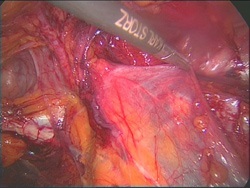A hernia occurs when an internal part of the body, such as an organ, pushes through a weakness in the muscle or surrounding tissue wall. Your muscles are usually strong and tight enough to keep your intestines and organs in place, but sometimes they are not, which causes a hernia.
Hernias may form through weaknesses in the abdominal wall viz. through the belly button (umbilical hernias), through the upper midline (epigastric hernias), and most commonly through the groin (inguinal or femoral hernias). For more information please click here.
Weakness in the abdominal wall could also result from surgical scars (incisional hernias) or following laparoscopy (port site hernias), or around stomas (when the bowel is brought on to the skin) (parastomal hernias).
Hernias are generally repaired in order to avoid the life threatening complication of strangulation ie entrapment of a knuckle of bowel in the defect, causing it to lose its blood supply.
There are two ways that a hernia repair can be carried out. These are laparoscopic or minimally invasive surgery, or open surgery.
We discuss the management of inguinal hernias here.
Keyhole (laparoscopic) surgery
This minimally invasive surgery can be performed in two ways: TEP (Totally Extra Peritoneal) when one operates by creating a potential space in the abdominal wall, without entering the peritoneal cavity or a TAPP (TransAbdominal Pre-Peritoneal) where one repairs the hernia by entering the peritoneal cavity. Mr Prabhudesai prefers the TEP procedure as there is no contact with bowel, as the peritoneal cavity is not entered and bowel damage including development of adhesions (scar tissue) in the future is avoided.
The advantage of key hole or minimally invasive surgery is that hernias in both groins can be operated on simultaneously; period of recovery is smaller and incidence of chronic pain is much less compared to an open repair. In the traditional open repair, if one has hernias in both groins, usually one side would be operated on at one time and the other side needs an operation later when the operated side has healed up. The laparoscopic technique is also useful when a hernia has recurred after a previous open repair.
However, one sided hernias can also be repaired by this minimally invasive technique. The NICE (National Institute for Health and Clinical Excellence) had initially issued guidelines, which stated that the laparoscopic technique should be used only in hernias on both sides or recurrent hernias, but it has since revised its recommendation, and has included repairs of hernias in one groin.
The principles of hernia repair by minimally invasive surgery are similar to open repair and a non absorbable mesh is used to strengthen the area, and to avoid recurrence (hernia coming back). Some hernias (e.g. large inguinal hernias going into the scrotum, incarcerated or strangulated hernias) are not suitable for the laparoscopic approach.
You will usually be able to go home on the same day, but some people stay in hospital overnight if they have other medical problems or if they live alone.


Open surgery
The surgeon makes an approximately 5cm cut in your groin. The inguinal canal (the channel near your bowel) is opened to return the fatty lump or loop of bowel to your abdomen, where it should be.
The wall of your abdomen is strengthened by fixing a patch of unabsorbable mesh to it.
In an emergency situation, if the hernia has become trapped (strangulated) and part of the bowel damaged, the affected segment may need to be removed and the two ends of healthy bowel rejoined. This is a bigger operation and you may need to stay in hospital for four to five days.
For more information please click here.

